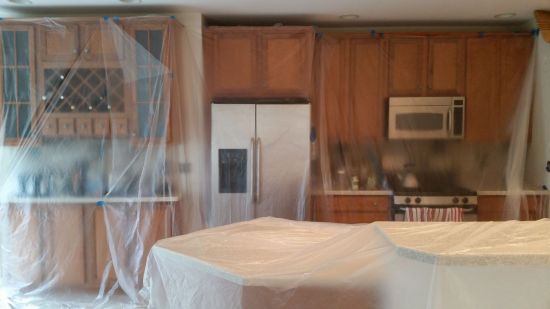October 8, 2012
Properly covering the floors, furniture, and other valuables of your interior painting project is the first step in creating an efficient work environment, one that allows you to work at a pace free from the worry or where occasionally stray paint might be landing.
Ideally, you’ll want to remove everything possible from the room being painted: wall coverings, rugs, and furniture. You can save yourself some time and back aches by pushing all the furniture to the center of the room, packing it all together so that you can get to the walls and windows in need of painting, rather than removing it completely from the room altogether.

Ground coverage is achieved through two primary means: drop cloths and plastic sheeting. Drop cloths are relatively inexpensive swaths of rugged canvas, in various square or rectangular dimensions. A well-placed “drop”—as we call them in the business—will keep any paint drips or spills from finding their way onto floors and carpets. You have to make sure that your drop cloths cover the amount of area they need to. Often times we’ll use multiple drops to cover one floor, just to guarantee that the floor is completely covered. For the more budget conscious, you can use old linens that you have lying around the house, but you want to test them first, and make sure that the fabric is thick enough to hold the paint on its top surface, without it leaking through to the bottom and onto your hardwoods or rugs. Many home owners make the mistake of using old bed sheets as drop cloths, but this is almost always ill-advised. Sheets are so thin that paint can bleed right through, and if the point is to keep paint off the floor, then an old bed sheet simply won’t do the job. Using two sheets, or multiple folds should usually do the trick.
Plastic sheeting, on the other hand, is a versatile protective tool used by professional painters everywhere. Plastic sheeting makes for a poor drop cloth, because it simply isn’t durable enough to withstand some one walking on it without ripping and tearing. Plastic sheeting looks like a giants version of plastic wrap: it comes on a roll in rectangular box, which can be spooled out and cut to precise lengths. Instead of protecting your leftovers, though, plastic sheeting is a great way to keep doorways and windows free from paint splatters. Just cut a piece of plastic to size, and tape it over the area in need. Plastic sheeting is also great for covering furniture and other valuables too big or bulky to carry out of the room. The best part about plastic sheeting is that it’s flexible but tough: as long as the plastic stays intact, no paint will ever get through.
So be sure to take your time and cover your floors, furniture, and valuables before cracking into that first can of paint—a little patience can save you a world of time.


